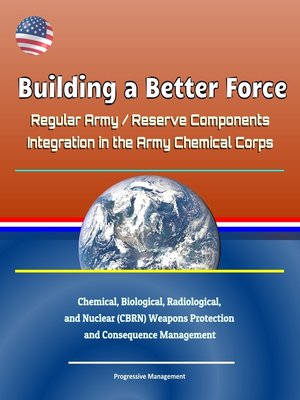Building a Better Force
ebook ∣ Regular Army / Reserve Components Integration in the Army Chemical Corps--Chemical, Biological, Radiological, and Nuclear (CBRN) Weapons Protection and Consequence Management

Sign up to save your library
With an OverDrive account, you can save your favorite libraries for at-a-glance information about availability. Find out more about OverDrive accounts.
Find this title in Libby, the library reading app by OverDrive.



Search for a digital library with this title
Title found at these libraries:
| Library Name | Distance |
|---|---|
| Loading... |
This report has been professionally converted for accurate flowing-text e-book format reproduction. Over the past twenty years, the mission of the Army Chemical Corps has evolved from a focus on protecting military forces against Chemical, Biological, Radiological, and Nuclear (CBRN) weapons to include the elimination Weapons of Mass Destruction (WMD), and CBRN consequence management. At the same time, an increased focus by both adversary state and non-state actors on acquiring WMD has increased the potential for their use. Due to both increasing mission requirements and emerging threats, the Army must seek to implement policies and systems that provide a Chemical Force capable of responding to the full range of CBRN threats and hazards. With more than eighty percent of the Chemical Force residing in the Reserve Components (RCs), it is necessary to integrate the total force to optimize Chemical Force effectiveness. Integration has been challenged by the implementation of statutes and policies that have erected institutional barriers between the Regular Army (RA) and RCs. This paper analyzes potential challenges and identifies opportunities for increasing the responsiveness and effectiveness of the Army Chemical Corps through RA / RCs integration.
1. Introduction * 2. The Transformation Discourse: A Capabilities Based Discussion, But is it Enough? * 3. The Unholy Trinity: The Contemporary Chemical Force and the Force of Change * 4. Three Teams, One Fight: Institutional Barriers to Total Force Integration * 5. Changing the Army's Culture: Moving Toward a Single Force Policy * 6. Conclusion
The challenges facing the Army for RA and RCs integration directly relate to institutional barriers erected over the past twenty-five years. While the Army National Guard (ANG) and Army Reserve (USAR) were initially established in the early 20th century to provide an accessible federal reserve force, over time, changes in the structure of, and relationships between, the RA and RCs have decreased their integration as a single force. The Total Force policy and Abrams doctrine adopted in the wake of the Vietnam War intended to irrevocably link the RA and RCs, but structural changes, including the creation of the U.S. Army Reserve Command (USARC) and elevation of the Chief of the National Guard Bureau (NGB) to a four-star general and member of the Joint Chiefs of Staff, have set the conditions for the components to operate as de fact services, and act in their individual interests, rather than the common interests of the service. These changes and the need for increased integration to ensure the readiness of the force to respond to emerging crisis requires the Army establish new policies that will enable the Chemical Corps to better integrate across all components.







